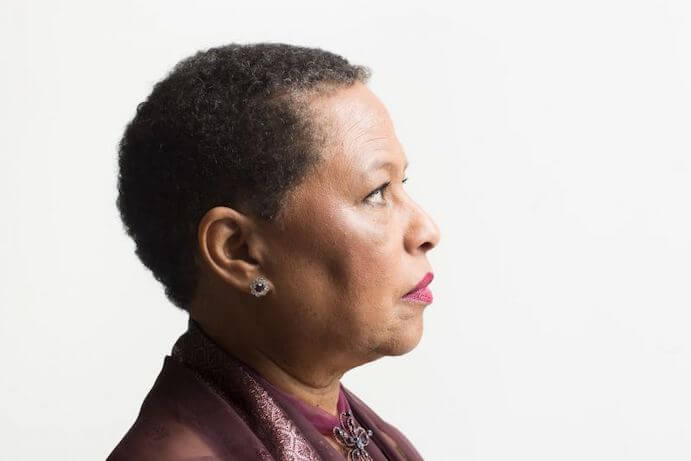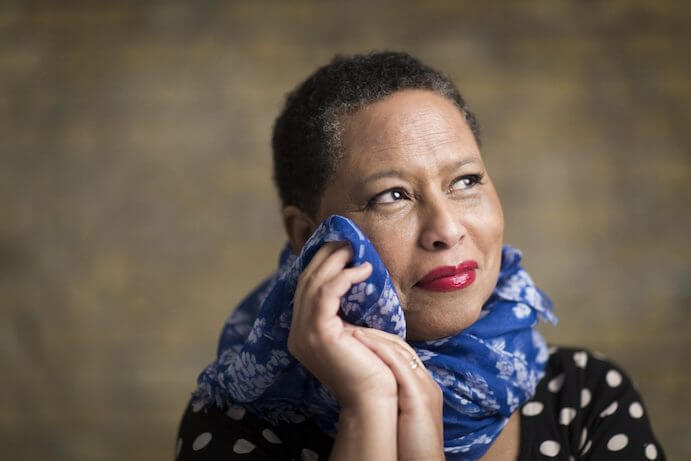British Jamaican composer Eleanor Alberga’s musical career has traversed a variety of occupations, collaborations, and musical styles. In addition to her work as a concert pianist, her experiences as a collaborator range from providing musical accompaniment for contemporary dance improvisations to participating in Jamaican and African folk ensembles. As a composer, Alberga has historically garnered attention for works that draw from her diverse musical background, including chamber and orchestral works such as Dancing With the Shadow (1990) and Arise Athena! (2015), as well as an opera, Letters of a Love Betrayed (2009). Her newest album, String Quartets 1, 2, & 3 (Navona Records, 2019), featuring Ensemble Arcadiana, presents her string quartets that draw more overtly from western art music’s stylistic canon.
Alberga’s string quartets prioritize compositional techniques that develop melodic and rhythmic motives, harmony, and counterpoint to create clear musical forms and distinct characters. This clarity and often episodic development can, in the context of the whole album, lead to predictability in longer tracks. However, persistent listeners are rewarded with several refreshingly innovative moments of timbral and textural exploration.

Alberga’s first and third string quartets were commissioned by the Maggini Quartet in 1993 and 2001 respectively. Maggini, who have a strong working relationship with Alberga, might have recorded the album were it not for the death of second violinist, David Angel (1954-2017), to whom the album is dedicated. Fortunately, Ensemble Arcadiana, comprised of Thomas Bowes (violin), Jacqueline Shave (violin), Oscar Perks (violin), Andres Kajuste (viola), and Jonathan Swensen (cello), have also worked closely with Alberga during the yearly Arcadia Festival, organized by Alberga and her husband Bowes. With this familiarity, Arcadiana brings spirited and energetic interpretations that effectively portray the variety of musical characters found in Alberga’s quartets.
Inspired by a physics lecture on the nature of matter and energy, Alberga’s String Quartet No. 1 begins explosively with a series of angular and energetic melodies that quickly develop into an intricate fugal texture. Following a roughly symmetrical form, melodic and rhythmic motives from this overture are developed through a series of texturally and characteristically varied episodes. Here, Arcadiana’s interpretation creates drama and suspense in sparser textures, broken by soaring violin duets over throaty cello tremolos and full ensemble interjections. The second movement takes a slower developmental pace, using breathless, unfurling melodies to depict the sensation of floating in near zero gravity. Alberga’s writing and Arcadiana’s interpretation show great attention to these melodies with carefully constructed phrases. The third movement pursues a similar thread of near continuous musical development, combing the first movement’s rambunctious moments and second movement’s high lyricism.
In String Quartet 2 (1994), Alberga iteratively develops the melodic, rhythmic, and harmonic material introduced in the opening bars of the piece. In the first half, the developmental episodes more overtly retain the opening material’s energetic, syncopated character, echoing the first and third movements in Quartet 1. The second half, however, takes a captivating and contemplative turn towards placid variations on the opening motive. A forlorn violin melody is adorned with wispy harmonic trills, giving way to lush supporting harmonies, finally transforming into a galavanting pizzicato texture. Here, Arcadiana takes greater interpretative risks, finding the full dynamic and timbral limits of Alberga’s writing with exquisitely paced phrasing.

String Quartet 3 (2001) synthesizes tonal and twelve tone techniques to create an expansive work in a traditional four movement form. Emanating from and returning to a single pitch center, the opening moderato movement uses these techniques within a now familiar pattern of continuous development. However, Alberga’s writing in this movement finds novelty with an increased timbral and textural palette providing depth to sweeping melodies well suited to Arcadiana’s soloistic experience. The second movement, “Scherzo,” playfully explores the string quartet’s high and low registers by creating angular contrapuntal line between the cello and upper voices. Arcadiana’s interpretation successfully finds humor and joviality in this texture, highlighting rhythmic interjections and the variety of characters present. The “Adagio” movement develops and juxtaposes the placid melodies from the first movement and the more active characters from the second. These juxtapositions progressively increase in intensity, dramatically culminating in several particularly sensitive melodies nestled within a delicate texture of wispy harmonic arpeggios and pizzicatos. The final movement, “Allegro,” synthesizes and heightens the musical characters found in the previous three movements. The shortest track of the whole album, Alberga’s writing and Arcadiana’s interpretations feel refreshingly directed, if a bit uncharacteristically low in energy.
Throughout the album, the individual soloistic virtuosity provided by the members of Ensemble Arcadiana deliver convincing and spirited performances. While this album will certainly serve as an important reference, Eleanor Alberga’s carefully constructed writing leaves room for other ensembles to take different interpretative approaches. As a result, the album will hopefully inspire interest in future performances and recordings of Alberga’s string quartets, as well as others from her output.
























